If you’re a hiker, you’ve probably put the Everest region near the top of your travel list. There are dozens of amazing trails within the mountains of Nepal, with Everest Base Camp taking the top spot for popularity. If you’re planning a trip or just starting to research the possibilities, here’s what you need to know about Everest trekking in Nepal:
Seasonality and Trekking Requirements
How do I prepare for the Everest region?
Preparing for a trek through the Everest region takes some serious preparation, both mentally and physically. Because you’ll be hiking in rapidly changing weather conditions, for long periods of time, and at high altitudes, you’ll be pushing yourself to some pretty serious limits.
- For altitude sickness, you may want to consider getting some medication. People respond to high altitudes in different ways, and while you may be fine on one trip, it doesn’t mean you’re never going to experience symptoms. Talk to your doctor a few months before your trek and get some medication prescribed.
- In terms of training, you’ll want to get out on the trails and hike as much as you can. Hiking for days at a time isn’t easy, and you don’t want your body to be shocked by a sudden increase in physical activity. Whether it’s at the gym or in your own backyard, get active and get ready.
- Your mental health is also extremely important during these hikes. There will be days that you’re tired, cold, and feel like giving up. Keeping a positive mindset, visualizing your own success, and learning to tough through the difficult times is going to make your trip a lot more successful.
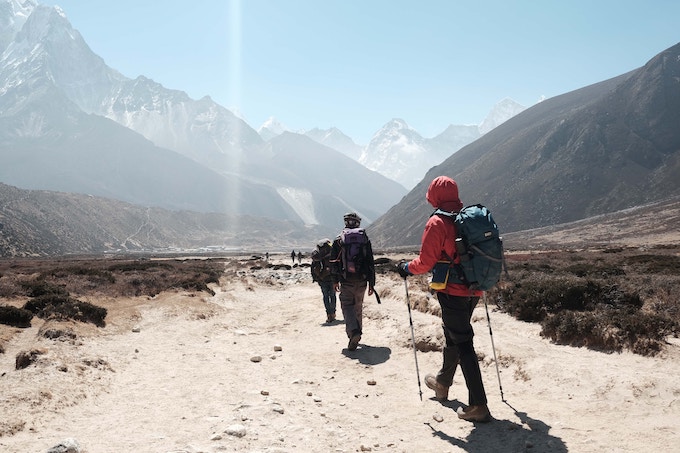
When should I trek around Everest?
Weather around Everest is extreme. Even extreme seems like an understatement. The weather is very volatile, meaning one minute is bright and sunny and the next there’s a downpour of rain or snow. It’s hard to predict and even harder to adapt to. Knowing the seasons will help make your trek planning a bit easier:
- In the summer months (June to August) there’s a lot of rain. It’s the regions monsoon season, so many tours don’t operate and the trails are closed. Typically, people avoid trekking at this time.
- October and November are the most popular trekking times, as the monsoon season has swept away and the trails have dried up. The views of the mountains are uninterrupted, making for a beautiful experience with warmer, more comfortable weather.
- The winter months, December to early March, are freezing cold, meaning few to no people tend to trek at this time.
- April to May is a special season, as the flowers are in full bloom and the temperatures are still manageable. While it’s not the most popular trekking season, it takes a close second.
What permits do you need to hike Everest?
As with any trip, there are permits required to explore and enjoy many parks or areas. While it can be a bit of a hassle, these permits ensure your safety and the safety of the areas you’re exploring. In Nepal, there are two major permits you’ll need:
TIMS cards
Additionally, you’ll need the Sagarmatha National Park
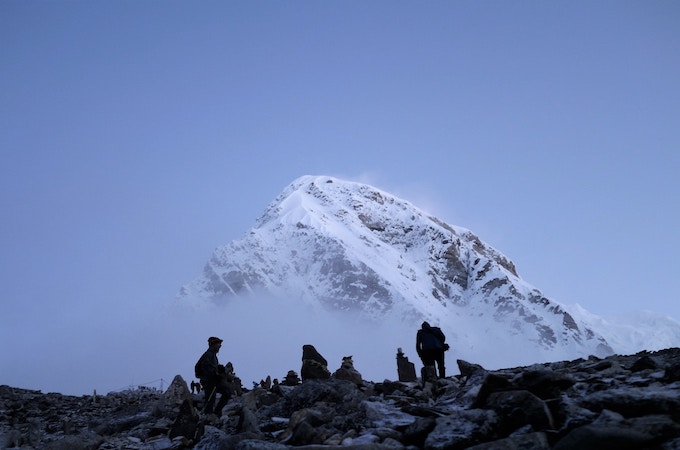
Do I need a guide to hike Everest?
Nepal is an excellent place for trekking solo, but only if you’re a well-equipped, confident, and capable hiker. For some of the routes you’ll need to be self-sufficient, which can mean hauling heavy gear and equipment. But if you’re up for the challenge, you’re good to trek as long as you have your permits.
On the other hand, this region has loads of amazing tour companies that are experienced in the area and are local experts. Having a guide often makes the trip easier to enjoy and a lot less planning is involved. If you’re looking for a hassle and worry-free experience or are new to trekking, hiring a local guide is the best option.
How do I get to the Everest region?
Most tours leave directly from Kathmandu. However, some treks involve another flight from the city to smaller surrounding airports, like Lukla. Ideally, book your tour for a few days after you arrive in Kathmandu. This gives your body time to acclimatize and your adventurous side time to explore the city.
What should I pack and what equipment do I need?
Packing for a trek through the Everest region is the same as every other hike, with a few key differences:
- Because the weather can change in an instant, it’s important to pack lots of layers. Warm socks that can be removed for thinner ones, a raincoat that can be taken of and replaced by a t-shirt, and hiking boots that can be swapped for flip-flops. Regardless of where you are in the region, there’s a high chance you’re going to see rain, snow, wind, and sun – so be prepared and make sure your gear is adaptable.
- If you’re a photographer, it’s always a good idea to bring along extra batteries, solar charging gear,
and a waterproof cover. Whether you’re staying in tea houses or camping, it’s always a challenge to find the right plugs. Plan ahead and have the necessary spare technology so your essential devices remained charged. - A great day pack is also an important item to bring. If you’re trekking with a tour company, most of your gear will be transported for you, but your day pack is your responsibility. That means it needs to carry all your daily essentials, without becoming too heavy or cumbersome. The perfect day hike for the Everest region is comfortable, small, and adaptable.
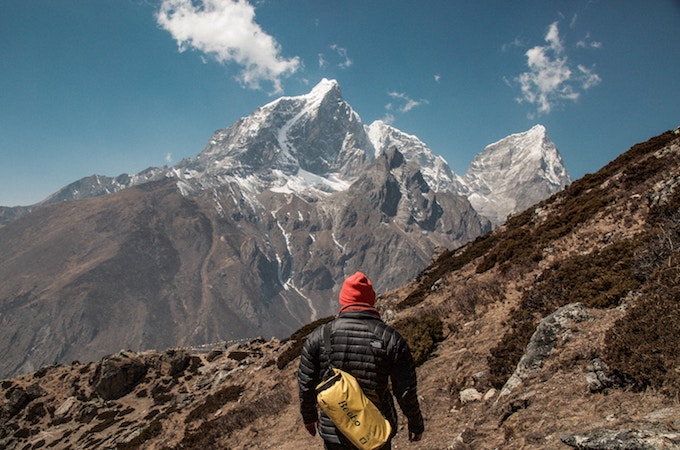
Best Everest Treks and Routes
Everest Base Camp
This trek is easily Nepal’s most famous trek, taking hikers through winding trails, river valleys, and alongside glaciers until arriving at the foot of Mount Everest. Each village and viewpoint along the way makes the hike both stunning and extremely rewarding.
- Average Duration: On average, this hike takes 13 days, but there are shorter and longer options.
- Average Difficulty: Hard. The trail is clear and well-established, however, the weather is unpredictable and the altitude creates unique challenges.
Gokyo Lakes Trek
This trek is the second most popular in the Everest region, coming in just after the Everest Base Camp Trek. During this trek, you’ll start by exploring the valleys beside the village of Gokyo, and then onto a series of beautiful and remote high-altitude lakes and villages.
- Average Duration: Typically takes between 12 and 15 days.
- Average Difficulty: The hike itself isn’t too difficult, but the high altitudes add an element of difficulty, especially for inexperienced hikers.
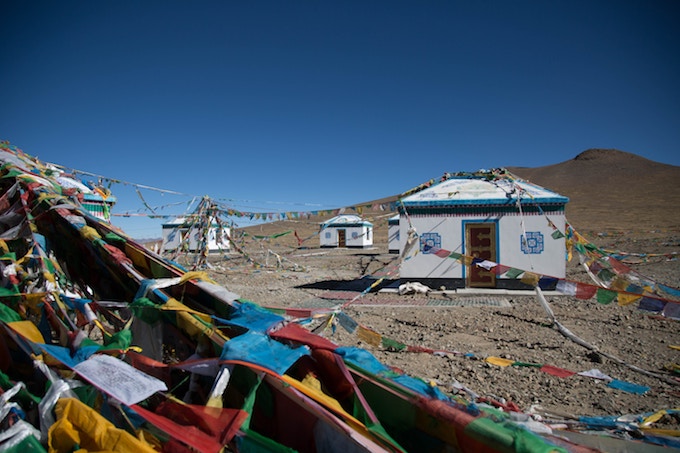
Three Passes Trek
This trek combines a little bit of everything into one challenging trek through the Everest region. The Three Passes Trek takes hikers around the entire loop of the Sagarmatha National Park, exploring the more remote and difficult mountain passes in the area.
- Average Duration: 14 to 21 days, depending on your tour company and hiking ability.
- Average Difficulty: This hike is very difficult, thanks to its remoteness and three passes all above 5000 meters.
Pikey Peak Trek
Some say the view of Mount Everest from Pikey Peak is the best in all of Nepal. And those who embark on this trek tend to agree. This hike is ideal for anyone looking to experience the region on stricter time restraints, but don’t want to compromise on adventure or beauty.
- Average Duration: Can be done in an intense three days, or a more relaxed six.
- Average Difficulty: With
the longer option, this trek is very leisurely and easy, making it a great option for new hikers.
Tengboche Monastery Trek
This trek allows hikers to experience the diversity the Everest region has to offer, from crossing bridges in pine forests to learning about Sherpa culture in the holy village of Tengboche. It’s an eye-opening combination of culture and nature, ideal for any spiritual traveller.
- Average Duration: Seven to 10 days is normal, but there are shorter tours that pack it all in as well.
- Average Difficulty: This trek is moderate, passing through easy and difficult sections that keep your heart rate fluctuating.
Everest Trekking Fun Facts
- Mount Everest is the highest peak in the region (and the world), coming in at 8,848 meters above sea level.
- It is over 60 million years old and was formed by the shifting Indian and Asian tectonic plates pushing together and upward.
- The North Base Camp of Mount Everest has an elevation of 5200 meters above sea level, triggering altitude sickness and snow bites amongst
travellers . - Kathmandu has the densest collection of UNESCO World Heritage Sites. Pashupatinath, the Swayambhunath, Boudha Stupa, Kathmandu, Bhaktapur, and Patan Durbar square are all within a
15-kilometre radius. - The lakes of the Gokyo Lakes Trek are at altitudes of 4700 to 5000 meters above sea level, making them some of the world’s highest freshwater lakes.
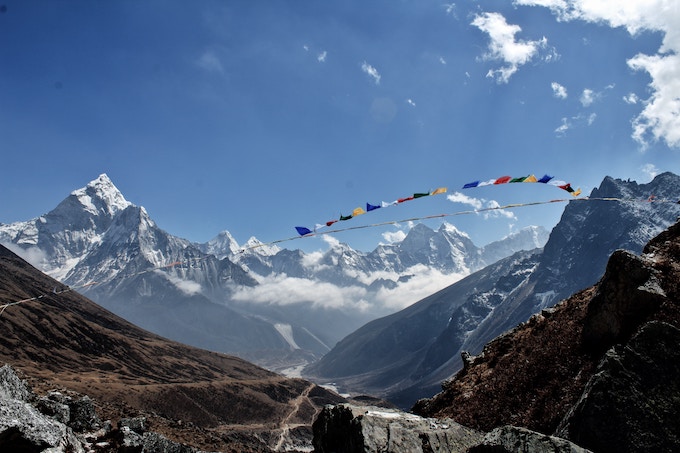
Everest Weather
Average Kathmandu Temperatures
Note that this region is significantly warmer than the mountains of Everest.
| Month | High/Low (°C) | Rain |
| January | 18° / 3° | 1 day |
| February | 21° / 5° | 2 days |
| March | 25° / 9° | 4 days |
| April | 28° / 12° | 5 days |
| May | 29° / 16° | 9 days |
| June | 29° / 20° | 13 days |
| July | 28° / 20° | 19 days |
| August | 29° / 20° | 17 days |
| September | 28° / 20° | 12 days |
| October | 26° / 14° | 5 days |
| November | 23° / 8° | 0 days |
| December | 20° / 4° | 0 days |
Average Everest Base Camp Temperatures
| Month | High/Low (°C) |
| January | 4° / -17° |
| February | 4° / -15° |
| March | 7° / -12° |
| April | 10° / -5° |
| May | 15° / 0° |
| June | 17° / 5° |
| July | 16° / 8° |
| August | 16° / 6° |
| September | 17° / 2° |
| October | 12° / -7° |
| November | 7° / -12° |
| December | 4° / -15° |
Everest Trekking is an incredible experience that not everyone gets to have in their lifetime. If you’re planning on undertaking this challenge, be sure to prepare mentally and phyically, and, most importantly, make sure you enjoy yourself!
Have you been trekking in Everest? Tell us all about it!

